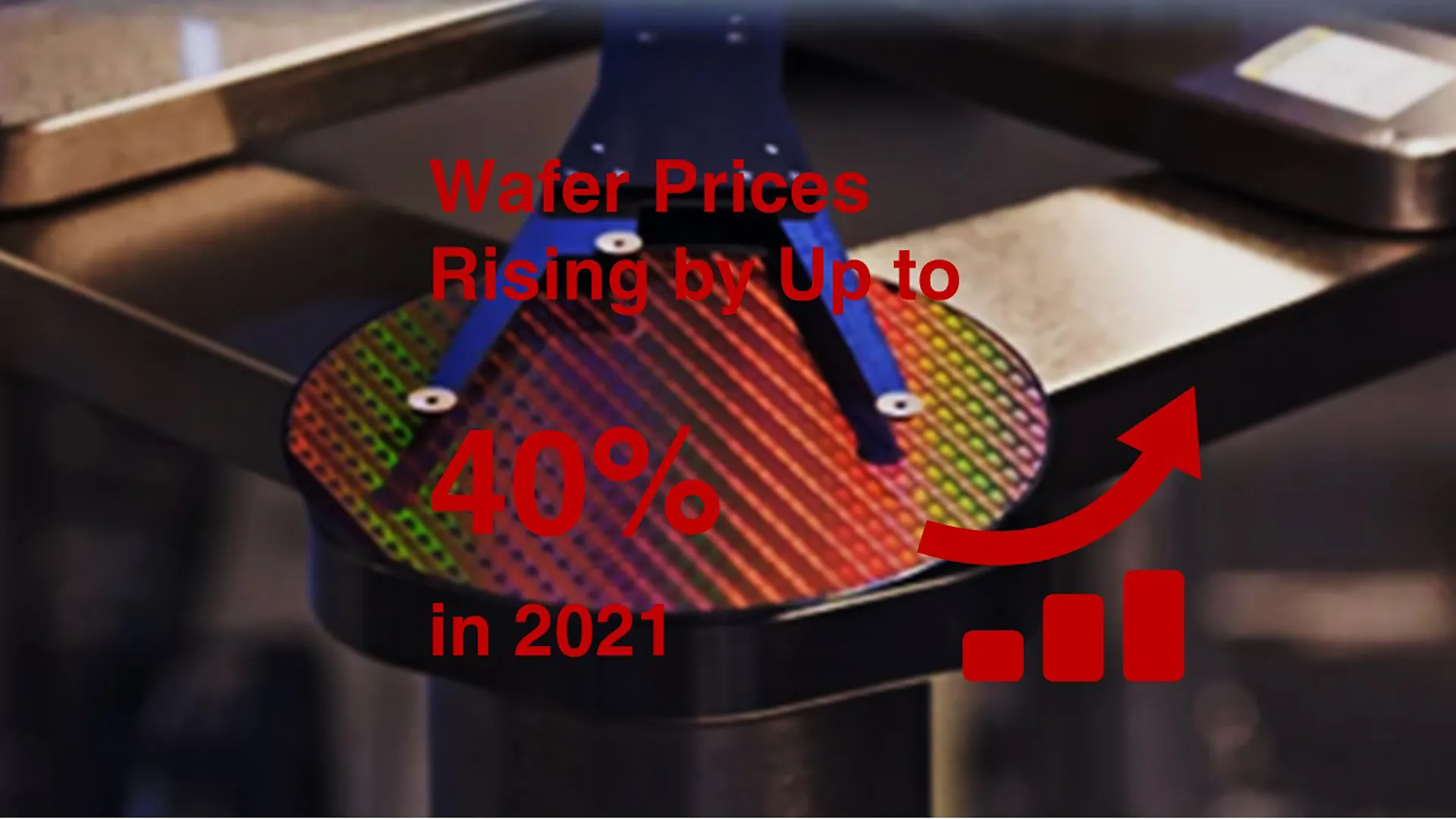8-inch Wafer Prices Rising by Up to 40% in 2021
Semiconductor foundries across the board are preparing to raise price quotes of their 8-inch wafers from 2021. A DigiTimes report sheds light on various foundry companies, including UMC (United Microelectronics), Global Foundries, and Vanguard International Semiconductor (VIS) have raised their 8-inch foundry quotes by 10-15% in Q4-2020, with the quotes set to rise by another 20-40% in 2021. Foundries don’t tend to use flat pricing, and instead rely on quotes specific to the size and design requirements of an order (by a fabless chip designer).
The foundry industry operates broadly on silicon fabrication nodes and wafer sizes. This article by Telescope Magazine provides insights into the typical use-cases for each wafer size. Although pertaining strictly to pricing of 8-inch (200 mm) wafers, an impending price-rise across the semiconductor industry can be extrapolated on the basis on significant labor cost increases.
Recently, many institutions have intensively visited relative semiconductor companies to investigate and try to inquire about the price increase of listed companies, who have received more than one round of research. At the level of listed companies, some companies directly acknowledge the price increase, while some companies ” Still holds partly concealed” and indirectly respond to the issue of price increases.
Reporter inquiry found that a number of semiconductor relative enterprises recently released the survey records showing that the rise in prices has become one of the most frequently asked questions of institutional research.
The research record released by Li-on Microelectronics on December 1 reflects the research situation of the institution from November 9 to November 27, during which as many as 43 institutions participated in the research.
The company focuses on the research and development and manufacturing of semiconductor materials, semiconductor chips and related products, and takes a leading position in the domestic semiconductor silicon wafer industry and schottky diode chip industry.
In the survey, the organization asked the company, “The company is currently in a relatively high industry boom, whose the main products are expected to increase in price?”
In this regard, Li-on Microelectronics gave a more positive answer. He said, “The current rising demand for semiconductors has triggered a supply shortage in the industry chain. The shortage of foundry capacity and price increases have driven the prices of silicon wafers, packaging and testing and IC design. The company’s semiconductor wafers and semiconductors driven by the continuous improvement of the integrated circuit market, the two businesses of discrete devices are currently having sufficient orders and full production capacity. The price rise of our products is affected by many factors. Based on the current market situation and the actual situation of our company, some products are negotiating with customers about the price rise. The final decision can only be made after negotiation with customers.
Like Li-on Microelectronics, another semiconductor company, Jiejie Microelectronics, also responded positively to the price hike in its research.
In the survey records released on November 30, for the company’s product structure and whether there is a price increase in the inquiry, Jiejie microelectronics made a more detailed response.
Thyristors accounted for 49% of the company’s total revenue in 2019. Due to the company’s product structure adjustment, it is expected to account for about 40% of revenue this year. The application areas of thyristors are mainly industrial control and home appliances as well as automotive electronics. On November 16 this year, due to factors such as price increases of some raw materials, product prices were adjusted (raised). MOSFET relative products accounted for 15% of the company’s total revenue in 2019 and will exceed 20% this year. The main application areas are industrial control and lighting. Due to the price increase of VD MOS and TRENCH MOS relative products this year caused by foundries, some products have been adjusted (upgraded). SGT MOS in future, mainly import substitution, has good profitability sustainability, price and gross margin are relatively high. Protective devices, which accounted for 20% of the company’s total revenue in 2019, will exceed 25% this year. Due to the escalation of the Sino-US trade war and the impact of import substitution for protective devices this year, some products have made some price increases, which are not large, with an average price of about 3%.
A slightly different from the above two companies is that NCEPOWER, whose main business is the R&D, design and sales of semiconductor power devices such as MOSFETs and IGBTs, has not responded positively to the price increase.
NCEPOWER expresses, the company is committed to the downstream customers to establish a long term friendly relations of cooperation, who has not begun to raise prices across the board.
However, in response to the agency’s ongoing questions about the company’s orders and the current industry’s prosperity, NCEPOWER said that the company’s downstream customers are currently in a state of strong demand according to its’ orders and communication with customers. As of now, the company’s orders in hand have been scheduled until 2021. The industry boom in this round is caused by a combination of many factors. The company is relatively optimistic about the industry boom in this round according to the company’s existing orders and communication with customers and peers.
From the stock price point of view, the recent stock prices of the aforementioned companies have been on the rise. Since November, both NCEPOWER and Li-on Microelectronics have increased by about 60%, while Jiejie Microelectronics has increased by about 30% as well.
The 8-inch wafer will rise 40% in 2021
The global 8-inch wafer foundry production capacity is hot, chip manufacturers are queuing up to increase prices to grab capacity, the fourth quarter quotations have been fully raised, and set off a wave of price increases.
The emergence of emerging applications and business opportunities, coupled with the advent of the 5G era, the continued growth of semiconductor demand, and the tight upstream foundry capacity in the industry chain caused by supply shortage and price increases are almost certain to continue until the second half of 2021.
According to the semiconductor supply chain, with the exception of TSMC and Samsung Electronics, other foundry companies have raised their 8-inch foundry prices, and the increase will start at least 20% in 2021. Queue-jumping orders can be as high as 40 percent, and demand for the 12-inch, 28nm process has risen more than expected.
It is worth noting that the semiconductor market is booming. In addition to the price increase of foundry, upstream silicon wafers, as well as packaging and testing and IC design, have also been followed up. Among them, as the global automotive market recovers, demand gradually strengthens. The production capacity of silicon wafers below 8 inches such as global crystal has also announced full capacity, including 12 inches, and spot prices are expected to rise.
The price of 8-inch wafers is outrageous
In terms of semiconductors, despite the previous weakness in the automotive market, the demand for terminal consumer electronics products has risen against the trend, and the specifications of 5G mobile phones have also been greatly upgraded. The semiconductor content has increased by more than 30% compared with 4G. Power management ICs, MOSFETs, and ultra-thin screens The consumption of chips such as fingerprint recognition, ToF, sensor IC and driver IC has increased significantly.
However, as many chips only require mature processes and mass production, the 8-inch foundry capacity is still unexpectedly tight during the first half of the epidemic crisis and the trade war crisis. Since the third quarter, the market has been in short supply. The out-of-wafer foundry will raise the price.
According to the semiconductor industry, due to insufficient 8-inch production capacity, it is difficult to expand in the short term, and chip companies have increased prices to snap up production capacity, thus establishing the trend of wafer foundry price increases, including Global Foundries (GF), UMC, and World Advanced With the influx of orders, foundry quotations in the fourth quarter increased by about 10~15%. Due to the high demand and limited capacity expansion of many factories, the increase of foundry will be at least 20%. Up to 40% in 2021.
The only exception is TSMC, which mostly combines mature and advanced process bundles. It has stated that it will not increase the price to damage the partnership due to short-term supply and demand issues.
In addition, the demand for the 12-inch 28nm process has also exceeded expectations, with an estimated increase of around 20%. For example, TSMC’s 28nm process has Sony, NXP, and FocalTech, Himax and other major manufacturers to place orders. Recently, there are also transfer orders from Qualcomm and Broadcom. UMC also has large orders for Korean OLED driver ICs.
The semiconductor industry pointed out that compared with TSMC, which had originally higher foundry prices, UMC, which has withdrawn from the advanced process competition, faced pressure from peer-to-peer price competition in the past, so the foundry quotes were low. Umc’s offer is expected to return to existing levels as capacity outpaces supply, and gross margins will rise significantly.
IC design, silicon wafer with the rise
It is worth noting that IC design companies have also raised their prices due to the rising costs of foundries. For example, Novatek and FocalTech adjusted their quotations according to different customers and orders. While upstream silicon wafers were originally fully loaded with 12 inches, and the original capacity utilization rate of less than 8 inches was only 70%. Now the global automotive market is recovering. Demand is rising rapidly, and production capacity is close to full capacity. Spot prices including Global Crystal and Waferwork will rise in 2021.
The seal goes up again
In terms of packaging and testing, the market has also reported that the cost of material such as IC substrates has risen in response to rising quotations, and various packaging orders have continued to flow in. ASE and other packaging and testing companies have gradually increased prices for new orders by 20-30% in the fourth quarters. Starting from the beginning of 2021, the average order price will be increased again by about 5-10%.
Semiconductor manufacturers said the recent price increases are likely to reflect cost changes for end-users as the semiconductor industry has experienced a wave of out-of-stock price increases, which are expected to run until the second half of 2021, due to a shortage of contract capacity for 8-inch wafer.
Source: DigiTimes






